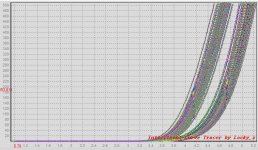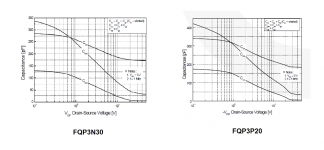IRF610/9610
Just for fun, I traced some IRF9610 and IRF610 parts. The 9610s are
at least 12 years old and 610s are probably 7+ years old. I don't know
if they are representative of current parts
Here's a graph for the 100 IRF610 and 67 IRF9610. They two group show
up as two distinct populations with no overlap in Vgs.
Cheers,
Dennis
Just for fun, I traced some IRF9610 and IRF610 parts. The 9610s are
at least 12 years old and 610s are probably 7+ years old. I don't know
if they are representative of current parts
Here's a graph for the 100 IRF610 and 67 IRF9610. They two group show
up as two distinct populations with no overlap in Vgs.
Cheers,
Dennis
Attachments
Just for fun, I traced some IRF9610 and IRF610 parts. The 9610s are
at least 12 years old and 610s are probably 7+ years old. I don't know
if they are representative of current parts
Here's a graph for the 100 IRF610 and 67 IRF9610. They two group show
up as two distinct populations with no overlap in Vgs.
Cheers,
Dennis
Dennis, what exactly do these traces show?
That trying to match 9610/610 devices by Vgs isn't likely to happen or that they match up quite well?
Thanks...
> That trying to match 9610/610 devices by Vgs isn't likely to happen
Correct. Same conclusion for IRF510_9510.
> or that they match up quite well?
This conclusion you cannot draw until you artificially shift the Vgs of one to coincide with the other.
And you need to zoom in to look at the range between 0 to 300mA.
But even if the curve would match, the Vgs difference would mean different bias resistor values.
This in turn means different open loop gain for the top and bottom half.
The same goes for the JFETs, when 2SJ74 has higher Yfs than 2SK170.
The whole thing has been discussed in detail in the F5 & F5X thread a few years ago.
http://www.diyaudio.com/forums/pass-labs/121228-f5-power-amplifier-174.html#post2277700
Patrick
Correct. Same conclusion for IRF510_9510.
> or that they match up quite well?
This conclusion you cannot draw until you artificially shift the Vgs of one to coincide with the other.
And you need to zoom in to look at the range between 0 to 300mA.
But even if the curve would match, the Vgs difference would mean different bias resistor values.
This in turn means different open loop gain for the top and bottom half.
The same goes for the JFETs, when 2SJ74 has higher Yfs than 2SK170.
The whole thing has been discussed in detail in the F5 & F5X thread a few years ago.
http://www.diyaudio.com/forums/pass-labs/121228-f5-power-amplifier-174.html#post2277700
Patrick
So summarising, the true complementary devices known to date from our measurements :
JFET TO92 :
2SK163 / 2SJ44 (obsolete)
MOSFET TO220 :
FQP3N30 / FQP3P20 (low match yield)
[Plus a pair of NOS device known only to the XEN team, but now obsolete and not available]
MOSFET TO3 or larger :
2SK1530 / 2SJ201 (low-ish match yield)
The Fairchild appears to be the only pair that is still active and easily available.
Patrick
JFET TO92 :
2SK163 / 2SJ44 (obsolete)
MOSFET TO220 :
FQP3N30 / FQP3P20 (low match yield)
[Plus a pair of NOS device known only to the XEN team, but now obsolete and not available]
MOSFET TO3 or larger :
2SK1530 / 2SJ201 (low-ish match yield)
The Fairchild appears to be the only pair that is still active and easily available.
Patrick
Precisely one of the concerns, and why true complementarity is unlikely. The mobility of holes in silicon is substantially less than that of electrons. You make a P device (DMOS or junction-based) with the same transconductance as an N device, it has to get larger and thus higher C in general.Does the input capacitance match also ?
If not, then why does such tight matching at dc matter (technically speaking ) ?
At low frequencies the matching of I-V curves is helpful, but I don't think you can get there with comparable capacitances. Nonetheless, I appreciate the effort and data, and I made a note of the Fairchild parts for further investigation. In the meantime for output stages I'd probably favor the Hawksford/Cordell et al. small local loop linearization approach, which makes the sensitivity to devices' static transfer functions much less.
pretty good cap match too
Taking a look at the datasheets, the capacitances ARE fairly close. The key here is that the P device has a lower D-S breakdown. But 200V is useful for a lot of things. I will definitely get some of these to play with, and thanks again to Patrick.Precisely one of the concerns, and why true complementarity is unlikely. The mobility of holes in silicon is substantially less than that of electrons. You make a P device (DMOS or junction-based) with the same transconductance as an N device, it has to get larger and thus higher C in general.
At low frequencies the matching of I-V curves is helpful, but I don't think you can get there with comparable capacitances. Nonetheless, I appreciate the effort and data, and I made a note of the Fairchild parts for further investigation. In the meantime for output stages I'd probably favor the Hawksford/Cordell et al. small local loop linearization approach, which makes the sensitivity to devices' static transfer functions much less.
My concerns are not about the specific application, but the general one of complementarity of P and N. And as I say, it looks as if these parts are very close in important ways when used in complementary topologies---all to the good.The circuit has -3dB bandwidth at >1MHz.
Even if the P device would have 3x higher capacitance, it would still be way above the audio band.
On top of that you can also play around with the gate resistor value.
I do not see any issues.
Patrick
Nelson named them already quite a while ago (August 2011).
http://www.diyaudio.com/forums/diyaudio-com-articles/194809-burning-amplifier-ba-3-a.html
I am just providing the evidence here.
Patrick
http://www.diyaudio.com/forums/diyaudio-com-articles/194809-burning-amplifier-ba-3-a.html
I am just providing the evidence here.
Patrick
- Home
- Amplifiers
- Pass Labs
- F5 Headamp ?

